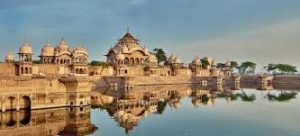 Culture of the city of Mathura is a blend of all its major aspects like its history, dance, art, architecture and festivals. The people of the city are deeply involved with the stories of the life of Lord Krishna. They sing folk songs and perform devotional dances. The festivals draw in flocks of pilgrims every year. Krishna Janmashtmi is the most important one and is celebrated with great enthusiasm. Other festivals of this sacred city are Diwali, Radhashtami, Besant Panchmi, Holi and more. Apart from these, there are ‘pujas’ and fairs as well. The food is rich in flavour and even though it has been influenced by the Mughal style of cooking, it is predominately vegetarian.
Culture of the city of Mathura is a blend of all its major aspects like its history, dance, art, architecture and festivals. The people of the city are deeply involved with the stories of the life of Lord Krishna. They sing folk songs and perform devotional dances. The festivals draw in flocks of pilgrims every year. Krishna Janmashtmi is the most important one and is celebrated with great enthusiasm. Other festivals of this sacred city are Diwali, Radhashtami, Besant Panchmi, Holi and more. Apart from these, there are ‘pujas’ and fairs as well. The food is rich in flavour and even though it has been influenced by the Mughal style of cooking, it is predominately vegetarian.
The ‘Braj’ culture that is reflected through various customs prevalent in Mathura involves a number of traditional practices such as Sanjhee and Rasiya. Sanjhee is an exclusive art of decorating the floor with colorful flowers while Rasiya is the traditional folk-songs that describe the divine love between Devi Radha and Lord Krishna. Rasiya folk songs are invariably recited at the time of all the festivals celebrated at Mathura; the chief amongst them being Holi. Holi Festival, popularly known as Dhulendi Festival in Mathura finds its origins in Braj culture itself.
Raaslila; the dance form originally supposed to have performed by Lord Krishna along with Devi Radha and the Gopikas of Gokul on the banks of the river Yamuna has now become an integral part of Indian Folklore. The Raaslila dance has been popular in Braj for past several centuries. According to the prevailing custom, only young Brahmin boys of the age of 13 to 14 years are allowed to perform the Raaslila. Charkula is yet another traditional folk dance from Braj region wherein a woman balances a column of lamps on her head and dances to the tunes of Rasiya songs sung by the men folk. Usually the number of lamps varies from 51 to108 in each performance.
The chief language spoken in Mathura is Hindi but what bring variation are its distinct dialects exclusive to the Braj province. The Hindi spoken in Mathura is known as ‘Brajbhasha’ which also used to be the principal language of the literature and poetry produced here until Hindi took over. Mathura is renowned for the brass and copperware items such as jewelry, jewel cases, caskets, Sindoor pots, plates, jars, lamps, hanging lamps, Peacock Deep, Shiv Trishul, vases, other decorative items, and so on. Apart from that, Mathura is also famous for its textile industry. The beautiful embroidery work done by the artisans of Mathura using precious and semi precious stones is well known far and wide.
The economy of the citizens of Mathura is supported by various industries flourishing here including Mathura Refinery (one of the biggest oil refineries of Asia), Silver Polishing Industry, Textile Printing Industry (sari-printing), Fabric Dyeing Industry, Water Tap Manufacturing Units, other decorative and household items manufacturing and so on. Moreover, Mathura has also been a booming center of manufacturing cotton materials; the chief amongst them being pure white bleached cotton saris, dhotis and cotton bed-sheets. Mathura is also a thriving hub of producing milk based sweets like Kesharia Peda, Burfi and other milk products such as ghee, cheese, butter, khurchan and so on.




